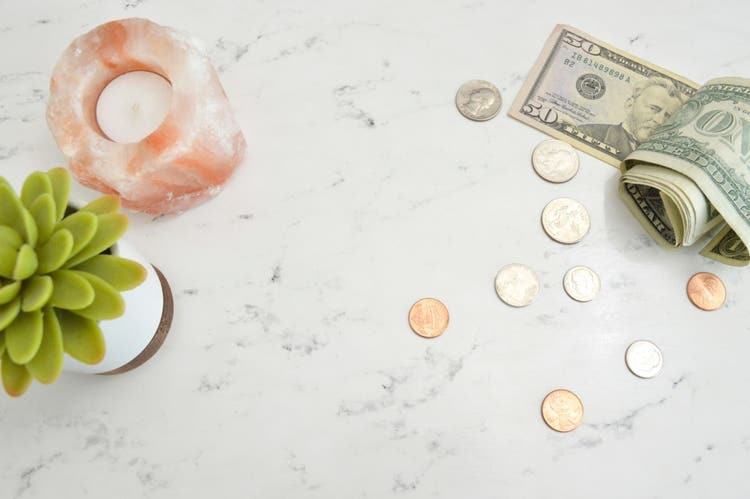Financial Wellness Trainer Danetha Doe Offers Tips for What to Do With Your Tax Return

Tax season is upon us, and many of us are eagerly awaiting our return, dreaming up all the ways we want to spend or save that money.
But what to do with that money can be tricky for many people. Should I save it, spend it, invest it? 24Life reached out to financial wellness expert and speaker Danetha Doe, creator of Money & Mimosas, which focuses on financial empowerment for everyone—but specifically women, to ask for her tips to navigating tax returns.
Below, Doe shares her breakdown of what to do with a refund should you receive one and how to turn your relationship with money around this spring.

What should I do with that tax refund?
The average person gets a $3,000 tax refund, Doe says. “That’s a nice chunk of change that can make a huge difference—to play around with or to make some really great decisions in the present moment or when planning for your future.”
If you’re getting a tax return, Doe recommends using the 50-30-20 rule.
Put away 50 percent for your future
No matter the amount, Doe recommends setting aside half of that refund for your long-term future goals, like saving for a home or for your children’s college education.
Use 30 percent for current, short-term goals
Next, Doe advises, put 30 percent of your refund toward any current, short-term goals you may have. This could be building up your emergency fund or paying down debt, she says.
“In my experience when talking to people who are getting a tax refund, the thought is that it’s smart to pay off all your debt or make a huge dent in your debt with your tax refund,” Doe says. “On the surface that may sound like a good idea, but you still want to make sure you’re setting yourself up to not have to tap into your credit cards, let’s say, in the future. And the only way to do that is to start building emergency savings.”
If you do not already have a solid emergency savings fund, or if you are using a traditional savings account, Doe advises putting that money into a high-yield savings account that has a higher interest rate.
“Look at using a high-yield savings account. These accounts are typically with banks that don’t have a physical retail location—so you won’t be able to walk into this bank,” Doe explains. “They’re usually 100 percent online. That’s part of the reason why they can offer a savings account that has a much higher interest rate.”
In addition to a high-yield savings account, Doe recommends looking into a Roth or SEP-IRA account. These accounts are great for investing in your retirement or for future planning. For example, if you’re anticipating shifting careers, with an individual retirement account, you don’t have to worry about transferring that money from one company account to another.
Spend 20 percent on yourself
At the end of the day, Doe says, it’s important to enjoy some of that money and spend it on yourself. Saving is important, but so is enjoying the money you’ve worked hard for.
“If we’re looking at $3,000, that’s $600. That’s a lot of money,” she says. “That could be an amazing spa vacation—you could really splurge and spoil yourself. Definitely, use 20 percent just to reward yourself and to have fun.”
Spring-cleaning your relationship with money
Tax season—which falls in early spring—is a great time to focus on your relationship with money, Doe says. Not only because you may be getting a significant amount of money back but because spring is also a time for reflection and fresh starts.
“Springtime is about renewal, rebirth. If you’ve falling off the wagon with your New Year’s resolutions, it’s OK because spring is here, flowers are blooming and you are blooming, as well. And so, now is the time to really be honest with yourself,” she says.
Doe advises sitting down and looking at your finances over the last three months.
- Do an assessment of where your money has gone, without judgment. Don’t label it as good or bad, just look at it and assess where you’ve been spending your money.
- If three months is too overwhelming, Doe says, try the last 30 days. Ask yourself, “How did I spend my money on the weekends? Did I spend a lot on transportation? Was I out at happy hour a lot?” Or conversely, maybe you didn’t spend a lot and you have been really doing well with your savings goals or investing goals.
- Then take a look at where your money is going “because consistent nurturing of a healthy money mindset, and shifting your mindset scarcity to abundance is all about awareness,” she says. “You have to first know how you’re behaving around money.”
- Once you know how you’ve been spending or saving your money over the last three months, then ask yourself, “Is this in alignment with where I want the end of the year to look like?” Take the last three months and multiply it by four. Is that where you want your savings to be, or your investing to be, or how much you’ve been spending to be?
- If not, start making a plan for changing your habits around money.
One way to do this, Doe says, is by having a weekly money date with yourself. Fridays are a great day, she says.
“Take 15 minutes to look at what you’ve been spending and how you’ve been spending over the last week and make adjustments, if needed. Transfer money to your savings or investing accounts on that Friday during your weekly money date, and just keep reminding yourself of the goals that you have set for yourself.”
Photo credit: Katie Harp, Unsplash; Courtesy of Danetha Doe